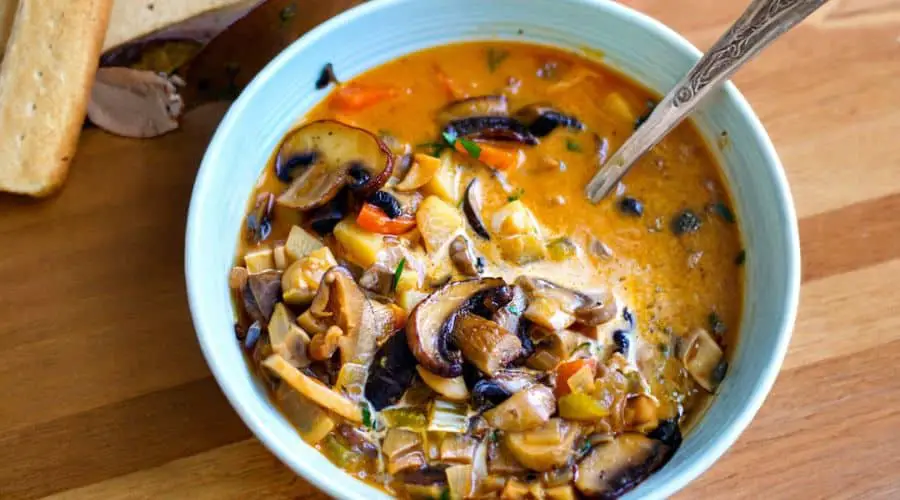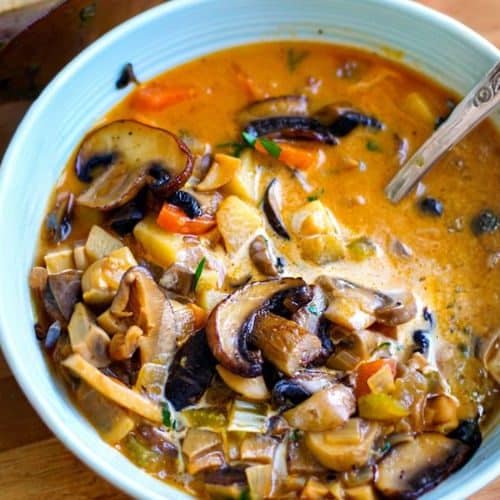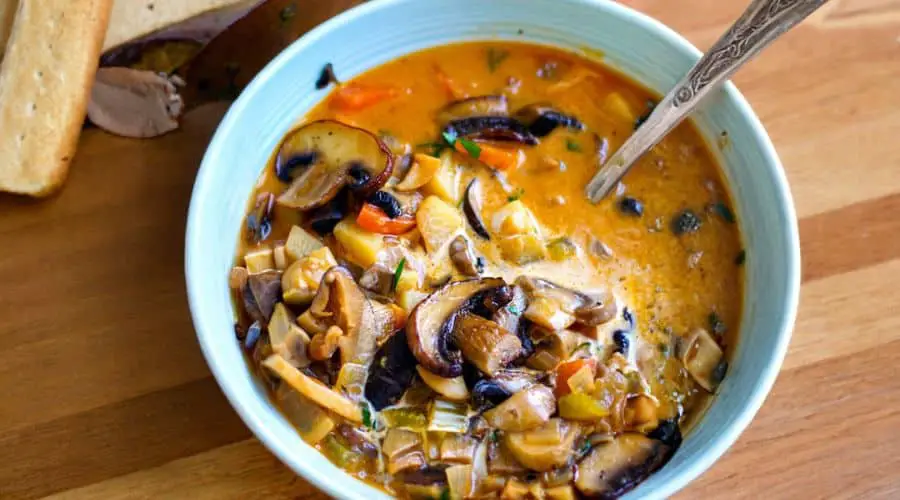This hearty mushroom stew stands out for its rich, deep flavor achieved by combining both fresh and dried mushrooms, delivering a delightful umami punch that elevates simple ingredients.
Beyond taste, it offers impressive health benefits: packed with fiber and plant-based protein, it supports digestion and sustained energy levels.
The moderate fat content primarily comes from healthy butter or olive oil, with optional cream adding a velvety finish without heaviness.

This stew is an excellent choice for everyday meals — it’s straightforward to prepare, naturally gluten-free, and perfect for batch cooking or leftovers.
Whether you’re a vegetarian or just looking to eat more plant-forward, nourishing meals, this recipe brings comfort, nutrition, and versatility to your table.
Must-Have Tools for Perfect Results
Large Saucepan
Ideal for simmering the stew base evenly. Its deep sides prevent spills and make stirring simple, doubling as a versatile pot for soups, sauces, and one-pot meals.
Frying Pan
Essential for sautéing mushrooms to achieve that perfect golden browning and concentrated flavor. A non-stick or stainless steel pan enhances even cooking and quick cleanup.
Mixing Bowl
Useful for creating the flour slurry that thickens the stew smoothly. A sturdy, medium-sized bowl is a kitchen staple for mixing, marinating, and serving.
Sharp Chef’s Knife
Crucial for finely dicing onions, carrots, and chopping mushrooms with precision and safety. A quality knife reduces prep time and improves overall cooking efficiency.
Measuring Cups and Spoons
Ensure accurate ingredient portions, helping maintain consistent flavor and texture every time you cook. Essential for following recipes and experimenting confidently.

Zucchini and Mushroom Garlic Stew
Equipment
- 1 large saucepan
- 1 Frying pan
- 1 Mixing bowl
- 1 Sharp Chef’s Knife
- Measuring Cups and Spoons (set)
Ingredients
- ½ cup dried shiitake mushrooms about 8-10
- ½ cup dried porcini mushrooms
- 1 cup boiling water
- 1 tablespoon butter or olive oil
- ½ large onion finely diced (split between stew base and mushrooms)
- 1 large carrot diced small
- 2 celery sticks diced small
- 2 medium white potatoes diced
- ½ teaspoon salt plus extra to taste
- 3 cups vegetable or chicken stock
- 1 tablespoon tomato paste
- 1 tablespoon soy sauce tamari, or coconut aminos
- 1 tablespoon butter
- 1 tablespoon olive oil
- 7 oz white button mushrooms 200g, sliced
- 7 oz Swiss brown or chestnut mushrooms 200g, sliced
- 3 cloves garlic finely diced
- Freshly ground black pepper pinch
- Juice and zest of ½ lemon
- 1 tablespoon flour arrowroot, tapioca, or regular
- ½ cup heavy cream or coconut cream
- 2-3 tablespoons chopped fresh parsley
Instructions
- Rehydrate the Dried Mushrooms: Begin by placing the dried shiitake and porcini mushrooms into a heatproof bowl or jar. Pour 1 cup of boiling water over them, ensuring the mushrooms are fully submerged. Allow them to soak for about 10 to 15 minutes, until they become soft and pliable. This soaking process not only softens the mushrooms but also extracts rich, earthy flavors into the soaking liquid, which will be used later to intensify the stew’s taste. Once rehydrated, carefully strain the mushrooms from the liquid, reserving the soaking water to add to your stew base.
- Prepare the Stew Base Vegetables: Heat 1 tablespoon of butter or olive oil in a large saucepan over medium heat. Once melted and shimmering, add half of the finely diced onion, the diced carrot, celery, and potatoes. Sprinkle the vegetables with ½ teaspoon of salt to draw out moisture and enhance their natural sweetness. Stir continuously for 2 to 3 minutes, allowing the vegetables to soften gently and develop a slight golden color on the edges. This step builds the foundational flavors of your stew and ensures the vegetables are tender by the time cooking is complete.
- Build the Broth and Simmer: Pour in 3 cups of vegetable or chicken stock, followed by the reserved mushroom soaking liquid (avoid adding any sediment at the bottom). Increase the heat and bring the mixture to a rolling boil. Once boiling, reduce the heat to medium-low and cover the saucepan with a lid. Let it simmer gently for approximately 5 minutes. This simmering softens the potatoes and melds the vegetable flavors, creating a comforting broth that will serve as the stew’s hearty base.
- Sauté Fresh and Rehydrated Mushrooms: While the stew base simmers, heat 1 tablespoon of butter and 1 tablespoon of olive oil in a frying pan over medium heat. Add the remaining diced onion along with ½ teaspoon salt. Cook for about 2 minutes, stirring occasionally, until the onion softens and becomes translucent. Chop the rehydrated mushrooms roughly, then add them along with the fresh sliced white button and Swiss brown mushrooms to the pan. Stir the mushrooms frequently over high heat for 3 minutes, allowing them to release their natural juices and begin browning. This process intensifies the mushrooms’ flavor and adds a delicious texture to the stew.
- Season and Brown the Mushrooms: Add the finely diced garlic, a generous pinch of black pepper, and the juice of half a lemon to the mushroom mixture. Continue cooking over medium-high heat for an additional 5 minutes, stirring occasionally, until the mushrooms are tender and develop a beautiful golden-brown hue. The lemon juice adds brightness and balances the rich umami flavors, making this component of the stew vibrant and aromatic.
- Combine Mushrooms and Stew Base: Carefully add the sautéed mushrooms, along with their flavorful pan juices, into the simmering stew base. Stir in the tomato paste and soy sauce (or tamari/coconut aminos) to enrich the broth with depth and a subtle savory kick. Increase the heat to bring the stew back to a gentle boil, then reduce it to medium-low, cover the saucepan again, and allow the flavors to marry by cooking for an additional 10 minutes. This final simmer ensures all ingredients meld perfectly, creating a harmonious and satisfying stew.
- Prepare and Add the Thickening Slurry: In a small mixing bowl, whisk together 1 tablespoon of your choice of flour (arrowroot, tapioca, or regular) with 2 to 3 tablespoons of cold water or some of the stew liquid. Whisk vigorously until you achieve a smooth, lump-free slurry. Gradually pour this mixture into the hot stew while stirring continuously. This careful incorporation prevents clumping and helps the stew thicken evenly. Turn off the heat once the stew reaches a slightly thicker, luscious consistency.
- Finish with Cream and Fresh Herbs: Stir in ½ cup of heavy cream or coconut cream, which adds a velvety richness and smooth mouthfeel without overwhelming the natural mushroom flavor. Taste the stew and adjust seasoning with additional salt and pepper as needed. Finally, fold in the freshly grated zest of half a lemon and 2 to 3 tablespoons of chopped parsley to brighten the dish with fresh, vibrant notes and a pop of color. The stew is now ready to serve piping hot.
- Serving and Enjoying Your Mushroom Stew: Ladle the stew into warm bowls and garnish with extra parsley or a sprinkle of grated Parmesan cheese if desired. This mushroom stew pairs beautifully with crusty bread, creamy mashed potatoes, or over a bed of grains like quinoa or rice. Enjoy immediately for the best texture and flavor, or store leftovers in an airtight container in the refrigerator for up to 4 day
Notes
Chef’s Secrets to Flavor Mastery
The secret to this stew’s rich flavor lies in layering ingredients thoughtfully.
Starting with sautéed onions and root vegetables develops a natural sweetness, while separately cooking the mushrooms intensifies their earthy notes without watering down the stew.
Using both fresh and dried mushrooms adds texture and umami complexity, enhanced further by the reserved soaking liquid.
Adding lemon juice and zest at the end brightens and balances the stew, preventing heaviness.
Also, making a smooth flour slurry to thicken the stew ensures a luscious, velvety texture without lumps.
Don’t rush the simmering steps, as slow melding of flavors makes a big difference in the final dish.
Serving Suggestions to Impress Guests
This mushroom stew is satisfying on its own but can be elevated with a few thoughtful pairings.
Serve it alongside warm, crusty artisan bread or over creamy mashed potatoes for a comforting meal.
For a lighter option, spoon it over steamed quinoa or brown rice, which soak up the flavorful broth beautifully.
A crisp green salad dressed with lemon vinaigrette adds a refreshing contrast to the stew’s richness.
For added indulgence, sprinkle some grated Parmesan or a dollop of sour cream on top.
It also works well as a cozy filling for baked potatoes or puff pastry shells, making it versatile for any occasion.
Storage Tips for Freshness and Flavor
Store leftover stew in an airtight container in the refrigerator for up to four days.
When reheating, warm it gently on the stove over low heat to avoid curdling the cream and maintain a smooth consistency.
If freezing, omit the cream during initial cooking and add it after thawing to preserve its texture and flavor.
Freeze in meal-sized portions using freezer-safe containers or bags, where it will keep for up to three months. Thaw overnight in the fridge before reheating.
To revive thickened stew after storage, add a splash of broth or water while warming to restore its perfect consistency.
Frequently Asked Questions About Mushrooms
1. Can I make this stew vegan or dairy-free?
Absolutely! Substitute butter with olive oil or vegan margarine, and replace heavy cream with coconut cream or a plant-based alternative. The stew remains rich and creamy without dairy.
2. Why use dried mushrooms instead of just fresh ones?
Dried mushrooms impart a deeper, concentrated umami flavor and add a subtle earthy complexity that fresh mushrooms alone can’t match. The soaking liquid also enhances the broth with extra depth.
3. Can I prepare this stew ahead of time?
Yes! The flavors develop even more after sitting overnight, making it a great make-ahead meal. Just reheat gently and add cream fresh if freezing.
4. What flour can I use to thicken the stew?
You can use arrowroot, tapioca starch, or regular all-purpose flour. Arrowroot and tapioca are great gluten-free options that give a silky finish without altering the flavor.
5. Is this stew suitable for low-carb diets?
While it includes potatoes and carrots, you can reduce the carb content by substituting potatoes with lower-carb vegetables like cauliflower or turnips. The mushrooms and cream provide good fats and protein to keep it satisfying.
This recipe is inspired by cookedandloved and has been carefully refined to enhance clarity, streamline preparation steps, and ensure accurate results. We’ve also included health benefits, nutritional highlights, and Must-Have Tools to help you get the best results every time you cook.


